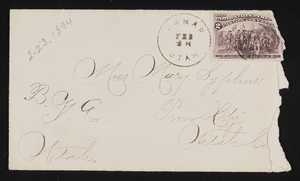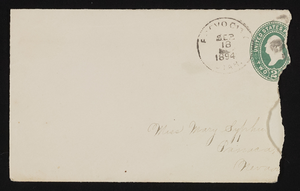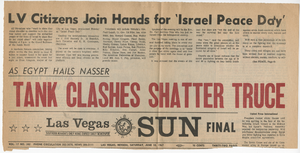Search the Special Collections and Archives Portal
Search Results

Meeting minutes for Consolidated Student Senate University of Nevada, Las Vegas, January 31, 1985
Date
Archival Collection
Description
Text

Letter and envelope from Nellie Harrison Kanab, Utah to Mary Etta Syphus, Provo City, Utah
Date
Archival Collection
Description
From the Syphus-Bunker Papers (MS-00169). The folder contains an original handwritten letter, an envelope, a typed transcription of the same letter, and a copy of original letter attached.
Text

Dorothy Eisenberg interview, March 8, 2017: transcript
Date
Archival Collection
Description
Multicultural advancements in Las Vegas cannot be mentioned without speaking on the monumental contributions of Dorothy Eisenberg. From 1971 to 1998, she was involved with over 25 local organizations and committees and had the honor of having an elementary school named after her. Eisenberg’s beginnings start in the midst of the all American melting pot experience though immigration. Her mother came to the United States from Russia at age twelve and her father from Austria at age sixteen to go upholstery school. Upon marriage, they settled down in Philadelphia after the World War II. They raised Dorothy and her siblings to contribute to the community despite the anti-Semitism that was displayed there on a regular basis. Signs that said, “No dogs and Jews allowed” were common place. After her first husband died, leaving her as a single mother of four little girls, she didn’t allow herself to be trampled by her circumstances by enrolling in Temple University to be a teacher at a time when the university had stigma towards older students. Upon her marriage to her second husband, the family moved to Las Vegas where she found a spiritual home for her family at Temple Beth Sholom, where her children went learned to deeply appreciate their Jewish heritage and attended Hebrew school. Having always been involved with politics in Philadelphia, she faced personal discrimination due to her religion when she was searching for organizations to involve her time. She eventually found a home with the League of Women Voters in 1965 and became involved with the Observers Corp and became aware of what was going on with the African American community from community based research and dialogue. She played a key role as president of the organization and faced heat for her involvement in the desegregation of sixth grade centers with the Kelly vs. Guinn decision in 1972 and was involved with the Welfare Rights Movement. She met Ruby Duncan and Jane Fonda, and she even showed up to the march with her daughters. Eisenberg was heavily involved with her namesake school through meetings with principals at least once a year, reading to students in the classroom, and bringing latkes to the school on Hanukkah. She continues the intergenerational legacy of educational involvement set forth by her parents with supporting her children, grandchildren and great grandchildren in the school as well. Dorothy Eisenberg is a true role model for Nevada and a pioneer for equal education in Las Vegas.
Text

Letter and envelope from Annie Rannow, Provo City, Utah to Mary Etta Syphus, Panaca, Nevada
Date
Archival Collection
Description
From the Syphus-Bunker Papers (MS-00169). The folder contains an original handwritten letter, an envelope, a typed transcription of the same letter, and a copy of original letter attached.
Text

Transcript of Interview with Michael Drakulich by Jane Finfrock, May 8, 1979
Date
Archival Collection
Description
Text
Galatz, Elaine
owner of Vegas Valley Morgans Horse Farms; widow of Neil Galatz (Las Vegas lawyer)
Person
Moss, Corinne "Corky", 1924-2001
Corinne “Corky” Moss (née Wollman; April 22, 1924 – 2001) was a philanthropist involved in establishing and supporting multiple educational and community efforts in Las Vegas, Nevada. She was the daughter of Murray Wollman, a Las Vegas landowner and developer, and his wife Agnes. The family moved to Las Vegas in 1936, where Moss graduated from Las Vegas High School in 1941. She graduated from Stanford University in 1945 and married Melvin S. Moss in 1946, with whom she had two daughters.
Person
Givens, Barbara, 1937-
Barbara Givens was born September 13, 1937 in California. She grew up in Reno, Nevada and moved to Las Vegas, Nevada in 1952 with her family when she was 14 years old. Givens graduated from Las Vegas High School and enrolled in the first matriculated teacher's program at the Southern Regional Division of the University of Nevada at Las Vegas (UNLV).
Person
Hantewn, Dallamy Santos
Dallamy has beautiful memories of her childhood in Cuba where she played on the beach and in the fruit orchards. Her parents were separated, so she grew up with her mother and her siblings. Her father was a school teacher who was going to school for his doctorate. He urged Dallamy to pursue higher education, so she began a teaching program and was well on her way to receive a federal scholarship. In her last year of school Dallamy decided instead to move to the United States with her then partner.
Person

